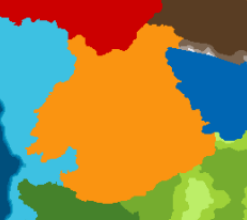Kanglaitam
This article is incomplete because it is pending further input from participants, or it is a work-in-progress by one author. Please comment on this article's talk page to share your input, comments and questions. Note: To contribute to this article, you may need to seek help from the author(s) of this page. |
Republic of Kanglaitam ପଖଂବା ଥା ଗି Pakhangba Thagi Kanglaitam | |
|---|---|
|
Flag | |
| Motto: Apunba panggal Strength in unity | |
| Anthem: Kanglaitam March | |
 Kanglaitam, highlighted in orange. | |
| Capital | Kanba Meitai |
| Official languages | Loktei, Agnian |
| Recognised national languages | Khaisi, Taigan, Paroyak, Singta, and more |
| Religion | Christianity |
| Demonym(s) | Kanglai |
| Government | Unitary presidential republic |
| Kshetrimayum Kurak | |
| Lukram Yaiphaba | |
| Legislature | National Assembly |
| Independence from Agnia | |
• Independence | May 19, 1951 |
| August 22, 1966 | |
| February 13, 1990 | |
• Republic established | June 8, 1997 |
| Population | |
• 2022 estimate | 22,867,043 |
| GDP (nominal) | estimate |
• Total | $648 billion |
| Currency | Phizo |
| Driving side | right |
Kanglaitam, officially the Republic of Kanglaitam (Agnian: República de Kanglaitam; Loktei: ପଖଂବା ଥା ଗି, romanized: Pakhangba Thagi Kanglaitam), is a country in western Stratea. It is bordered to the north by Seocheon, to the east by Narulia, and to the west by the Achrinian Ocean. The country's capital and largest city is Kanba Meitai while other major cities include Channa, Hethoi, and Yai Phuro. Kanglaitam has a population of 22 million inhabitants.
Kanglaitam was first settled around 7,000 BCE. From around 2,000 BCE onwards, a number of different states existed in what is now modern Kanglaitam. The fledgling empire of Agnia first reached Kanglaitam in 1577, where it established trading posts and relations with the coastal states of the region. The most influential of which was the Tei Rai Kingdom, a Loktei state. Beginning in the mid 1600s, Agnia began to colonize the region, eventually controlling the entirety of what is now Kanglaitam as part of its "Kanglai Territory". Following the Second Great War, pro-independence desires emerged in Kanglaitam which were led by groups such as the Kanglai Freedom Front and the Loktei nationalist Ireibak Ayetpa. Agnia granted Kanglaitam independence in 1951 following widespread unrest and protest against the colonial administration.
Independent Kanglaitam took the form of a republic, which existed until a coup, known as the August Revolution, was carried out by the Ireibak Ayetpa movement in 1966. The Ireibak Ayetpa established a totalitarian dictatorship, known as Revolutionary Kanglaitam, which lasted until 1997. Revolutionary Kanglaitam was characterized by the domination of the majority Loktei ethnicity and widespread atrocity and repression, which would eventually lead to a separatist uprising led by armed groups affiliated with minority communities. The authoritarianism of the Ireibak Ayetpa would even alienate many Loktei and a protest movement that was brutally suppressed would begin the Kanglaitam Civil War in 1990. Rebel forces reached the capital in mid-1997, establishing the modern day republic. The Ireibak Ayetpa were never fully defeated and retreated into the mountainous northern regions, where they continue to wage an insurgency against the republican government. The current conflict has also expanded to include various drug trafficking organizations, which the Ireibak Ayetpa is accused of supplying and working alongside.
